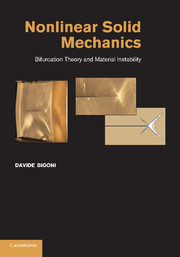Book contents
- Frontmatter
- Contents
- Preface
- Foreword by Giulio Maier
- 1 Introduction
- 2 Elements of tensor algebra and analysis
- 3 Solid mechanics at finite strains
- 4 Isotropic non-linear hyperelasticity
- 5 Solutions of simple problems in finitely deformed non-linear elastic solids
- 6 Constitutive equations and anisotropic elasticity
- 7 Yield functions with emphasis on pressure sensitivity
- 8 Elastoplastic constitutive equations
- 9 Moving discontinuities and boundary value problems
- 10 Global conditions of uniqueness and stability
- 11 Local conditions for uniqueness and stability
- 12 Incremental bifurcation of elastic solids
- 13 Applications of local and global uniqueness and stability criteria to non-associative elastoplasticity
- 14 Wave propagation, stability and bifurcation
- 15 Post-critical behaviour and multiple shear band formation
- 16 A perturbative approach to material instability
- References
- Index
- Plate section
Foreword by Giulio Maier
Published online by Cambridge University Press: 05 August 2012
- Frontmatter
- Contents
- Preface
- Foreword by Giulio Maier
- 1 Introduction
- 2 Elements of tensor algebra and analysis
- 3 Solid mechanics at finite strains
- 4 Isotropic non-linear hyperelasticity
- 5 Solutions of simple problems in finitely deformed non-linear elastic solids
- 6 Constitutive equations and anisotropic elasticity
- 7 Yield functions with emphasis on pressure sensitivity
- 8 Elastoplastic constitutive equations
- 9 Moving discontinuities and boundary value problems
- 10 Global conditions of uniqueness and stability
- 11 Local conditions for uniqueness and stability
- 12 Incremental bifurcation of elastic solids
- 13 Applications of local and global uniqueness and stability criteria to non-associative elastoplasticity
- 14 Wave propagation, stability and bifurcation
- 15 Post-critical behaviour and multiple shear band formation
- 16 A perturbative approach to material instability
- References
- Index
- Plate section
Summary
This book clearly exhibits some remarkable and unusual features. The central theme addresses one of the primary research challenges at present in solid and structural mechanics. In fact, research on nonlinearities owing to large deformations and inelastic behaviours of materials now has to be tackled for many systematic applications in mechanical and civil engineering because the evaluation of safety margins has become computationally possible, with obvious advantages when compared with “admissible stress” criteria, popular in past structural engineering practice.
The content of this book reflects the intensive and successful research work carried out by the author and his co-workers both at the University of Trento and at other institutions. The detailed introduction includes several clear illustrative descriptions of experiments and, hence, solid links with practical motivation and application for the book's content. It seems that in his writing, Davide Bigoni has been mindful of Cicero's admonition not always implemented in books on mechanics: ‘Non enim paranda nobis solum, sed fruenda sapientia est’ (‘The knowledge should not only be acquired; it should be utilized as well’). Isaac Newton expanded on Cicero's advice when he wrote, ‘Exempla docent non minus quam praecepta’ (‘Examples are not less instructive than theories’). In fact, the subsequent chapters include many examples to clarify notions of applied mathematics and theoretical continuum mechanics.
The mathematics and physics covered in this volume are not easily found in the existing engineering-oriented literature in the consistent manner presented herein.
- Type
- Chapter
- Information
- Nonlinear Solid MechanicsBifurcation Theory and Material Instability, pp. xv - xviPublisher: Cambridge University PressPrint publication year: 2012



